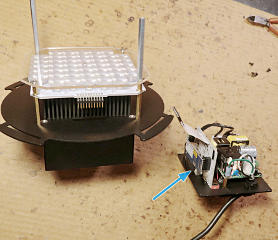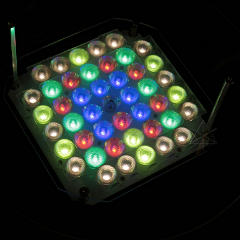
|
I don't remember how I first learned of
this product's
availability, but
a directly-installable LED retrofit for old PAR64 or PAR56 fixtures did
seem like an intriguingly sensible thing.
I could immediately think of two or three venues and gear inventories that
could benefit from something like this, radically cutting power requirements
and having full color capability by simple reclamation of lights whose
usefulness would otherwise keep declining.
And there were strong hints that this wasn't typical cheap offshore crap,
but rather of domestic design and manufacture.
The website had a phone number, so I called it with some questions ready. I wound up talking to the founder, which in retrospect made sense since Luxium / Luxapel appears to be two or three guys working out of someone's garage. But the conversation was pleasant and reasonably technical, which I always appreciate. Later I sent some email with further questions as they'd come up, and got a reasonably coherent reply from the same fellow. The LED units could be equipped with wireless DMX, and the claim was that in the wireless mode, the physical wired ports would act as repeaters and relay the DMX as local signal sources. Think about that -- anywhere at least one of these units was deployed, no physical long DMX wire would in theory be needed to reach that position from the console! This feature was quite attractive given the setup of several events I routinely work on, where cabling paths around the venues are often a bit of a design headache. Since larger purchase quantities could bring deeper per-unit discounts, I tried to get some other par64-owning collaborators interested, but that didn't really go anywhere constructive. The quantity I personally would need was only four, but I inquired about how to start the purchase process based on that anyway. Then the flaws within Luxapel began to emerge, specifically that of being really disorganized from an actually-doing-business perspective. I received a quote for way more per-unit cost than we had discussed via email, and the pricing on a wireless DMX transmitter was exactly the same number so that distinctly looked like a copy/paste typo. We were also trying to work out how I could test various optical diffusion media kits they could offer, and figure pricing for that. Back and forth some more, and finally on the *third* emailed PDF quote they seemed to actually get it right. Almost. But at least the buying process had been launched -- they asked for half the total up front, and accepted Paypal which I had finally and grudgingly set myself up with. The shipment showed up about a week later, except minus the wireless DMX transmitter, so to begin testing I would have to take apart at least one unit and pull out its wireless receiver to enable the RJ45 wired DMX ports to receive from a controller. [More on this particular travesty below.] |

|
Four corner screws out and the back comes off the module, bringing all the works and the ribbon cable from the LED plate with it. The bulk of the parts volume is an off-the-shelf power supply, which produces a surprisingly high 22 VDC. But I suppose that's appropriate to running strings of LEDs in series. Inserted into a header on the control board is the wireless "W-DMX" module [blue arrow]. That's another off-the-shelf part from "Wireless Solution" or Lumenradio or wirelessdmx.com or whoever they are this week. |

|
Leaving the W-DMX module out and partially reassembling did allow for
wired DMX control, and then I could actually hook up
a console
to one of the RJ45 jacks and start playing with the module.
Here's the emitter matrix: separate red, green, blue, lime, and white, as opposed to multi-output chips like in the Rokboxes. Each LED chip on the output board has basically 180 degree emission, which is all caught by a lenslet that sends it into a roughly 20-degree beam. The white emitters produce a surprisingly warm color temperature, more like that of the par lamps these are intended to replace than the cold blue-whites we normally expect from white broadband phosphor emitters. The units normally occupy 4 DMX slots, so we don't directly control the lime emitters -- they come on automatically at an appropriate level to augment the spectrum between red and green. Dimming is very smooth, with no evidence of "quantization" or flicker in the output, especially where it tends to be most noticeable at the bottom in other LED fixtures. |
| After a little back-and-forth with the Luxapel guy who was convinced that he had shipped the wireless DMX transmitter when in fact he had not, I found a related inconsistency on his invoice where our agreed-upon price for it wasn't even included in the total. He finally found it still sitting around the shop, said "Oops", and overnighted it. So now I could start testing the wireless functionality, pairing and unpairing lights, and the claimed re-transmission of a full DMX universe out the wired side of every unit. If this worked as I assumed, it would be a super-handy feature for events, eliminating DMX cable runs to any part of the rig where these units were hung. |
|